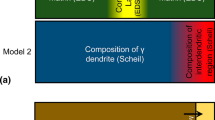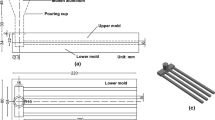Abstract
Theories on fluidity of alloys based on the solidification mode are not satisfactory in describing fluidity of alloys under high-pressure die casting (HPDC) conditions. To understand the flow-choking mechanisms under HPDC conditions, microstructure in the fluidity test coupons made using a 125-ton HPDC machine was characterized. Pre-solidified dendrites (PSDs), or externally solidified crystals (ESCs), which were formed in the shot sleeve, were found in the runners as well as in the fluidity casting. Surprisingly, a large amount of PSDs are collected in the runner adjacent to the in-gate, forming a PSD core with a thin layer of PSD-less or PSD-free region near the surfaces of the runner due to Magnus effect. Analytical calculations were performed to estimate the pressure drop for molten aluminum flowing through the mushy PSD zone. The results indicate that the pressure drop is comparable to the maximum pressure that was used for injecting molten metal to fill the casting. When the pressure drop is equal to the pressure driving the mold filling, the metal ceases to flow. Thus, it is the PSDs that are responsible for the choking of mold filling either mechanically at the in-gate or providing a pressure drop high enough to resistant fluid flow.








Similar content being viewed by others
Abbreviations
- C i :
-
Bulk composition of the ith element in an alloy (wt pct)
- C 0 :
-
Bulk composition of an element (wt pct)
- C Si :
-
Bulk composition of Si (wt pct)
- C Cu :
-
Bulk composition of Cu (wt pct)
- C Zn :
-
Bulk composition of Zn (wt pct)
- C Mg :
-
Bulk composition of Mg (wt pct)
- C Fe :
-
Bulk composition of Fe (wt pct)
- C Mn :
-
Bulk composition of Mn (wt pct)
- C P :
-
Specific heat (1.08 × 103 J/kg K)
- C PE :
-
Equivalent heat capacity
- d 2 :
-
Secondary dendrite arm spacing (μm)
- d C :
-
Dendrite cell size (μm)
- D ii :
-
Diffusion coefficient of the ith element in the liquid
- D Si :
-
Diffusion coefficient of Si in the liquid (3.3 × 10−9 m2/s)[1,2]
- D Cu :
-
Diffusion coefficient of Cu in the liquid (3.3 × 10−9 m2/s)[1,2]
- D Zn :
-
Diffusion coefficient of Zn in the liquid (3.3 × 10−9 m2/s)[1,2]
- D Mg :
-
Diffusion coefficient of Mg in the liquid (3.3 × 10−9 m2/s)[1,2]
- D Fe :
-
Diffusion coefficient of Fe in the liquid (3.3 × 10−9 m2/s)[1,2]
- D Mn :
-
Diffusion coefficient of Mn in the liquid (3.3 × 10−9 m2/s)[1,2]
- f S :
-
Fraction solid
- f L :
-
Fraction liquid
- h :
-
Heat transfer coefficient (7.0 × 103 W/m2/s)
- k C :
- k i :
-
Solute distribution coefficient of the ith element
- k Si :
- k Cu :
- k Zn :
- k Mg :
-
Solute distribution coefficient of Mg 0.30
- k Fe :
- k Mn :
- K S :
-
Permeability
- m i :
-
Equilibrium liquid slope for the ith element
- m Si :
- m Cu :
- m Zn :
- m Mg :
- m Fe :
- m Mn :
- N :
-
Number of solute elements in a multi-component alloy
- L :
-
Latent heat of the primary aluminum phase (3.96 × 105 J/kg)[1,2]
- p :
-
Pressure
- q :
-
Mean cooling rate on solidification (K/s)
- S V :
-
Surface area of solids per unit volume of specimen (8.0 × 104 1/m)[3,4]
- t C :
-
Local solidification time = (TL − TS)/q (s)
- T :
-
Temperature (K)
- T 0 :
-
Liquidus at C = C0 (K)
- T m :
-
The melting temperature of a dendrite with a tip curvature of zero (933 K)
- T L :
-
Liquidus for 380 aluminum alloy 856 K (583 °C)
- T S :
-
Solidus for 380 aluminum alloy 779 K (506 °C)
- V :
-
Velocity (m/s)
- σ :
- φ :
- ρ :
-
Density (kg/m3)
- µ :
-
Viscosity (2.09 ×10−3 N s/m2)
References
13. Q. Han, H. Hu, and X. Zhong: Metall. Mater. Trans, 1997, vol. 28B, pp. 1186-1187.
14. Q. Han and S. Visvanathan: Light Metals 2000, 2000, pp. 609-613.
20. A.J. Duncan, Q. Han, and S. Viswanathan: Metall. Mater. Trans., 1999, vol. 30B, pp. 745-750.
21. Q. Han, A.J. Duncan, and S. Viswanathan: Metall. Mater. Trans., 2003, vol. 34B, pp. 25-28.
M.K. Kallas: US Patent Application Number 15874348, July 18, 2019.
2. D.V. Ragone, C.M. Adams, and H.F.Taylor: Trans. AFS, 1956, vol. 64, pp. 653-657.
3. M.C. Flemings: Britain Foundry, 1964, vol.57, pp.312-325.
4. M.C. Flemings, E. Niyama, and H.F. Talor: Trans. AFS, 1961, vol. 69, pp.625- 630.
5. M.C. Flemings: Solidification Processing, New York: McGraw-Hill, 1974.
Campbell J (2000) Castings. Butterworth-Heinemann, Oxford, pp 72-85
7. Q. Han and H. Xu: Scripta Mat., 2005, vol. 53, pp. 7-10.
A.T. Noble, C. Monroe, and A. Monroe: NADCA Trans, 2013, T13-101.
9. P. Semanco, M. Fedak, M. Rimar, and T. Ragan: Adv. Mater. Research, 2012, vol. 505, pp. 190-194,
R.A. Miller: NADCA Trans, 2016, T16-081.
R.A. Miller: NADCA Trans, 2015, T15-092.
Tiryakioğlu M (2019) Mater Sci Technol 35:509-511
G. Magnus: Abhandlung der Akademic der Wissenschaftern, Berlin, 1852.
16. S. Goldstein: Modern Developments in Fluid Dynamics, Clarendon, Oxford, 1938, p. 83.
17. Q. Han and J.D. Hunt: ISIJ International, 1995, vol. 35 (6), pp.693-699.
Han Q, Hunt JD (1995) J Cryst Growth 152:221-227
19. P.C. Carman: Trans. Inst. Chem. Eng. (London), 1937, vol. 15, pp. 150-156.
Author information
Authors and Affiliations
Corresponding author
Additional information
Publisher's Note
Springer Nature remains neutral with regard to jurisdictional claims in published maps and institutional affiliations.
Manuscript submitted January 15, 2020.
Rights and permissions
About this article
Cite this article
Han, Q., Zhang, J. Fluidity of Alloys Under High-Pressure Die Casting Conditions: Flow-Choking Mechanisms. Metall Mater Trans B 51, 1795–1804 (2020). https://doi.org/10.1007/s11663-020-01858-0
Received:
Published:
Issue Date:
DOI: https://doi.org/10.1007/s11663-020-01858-0




